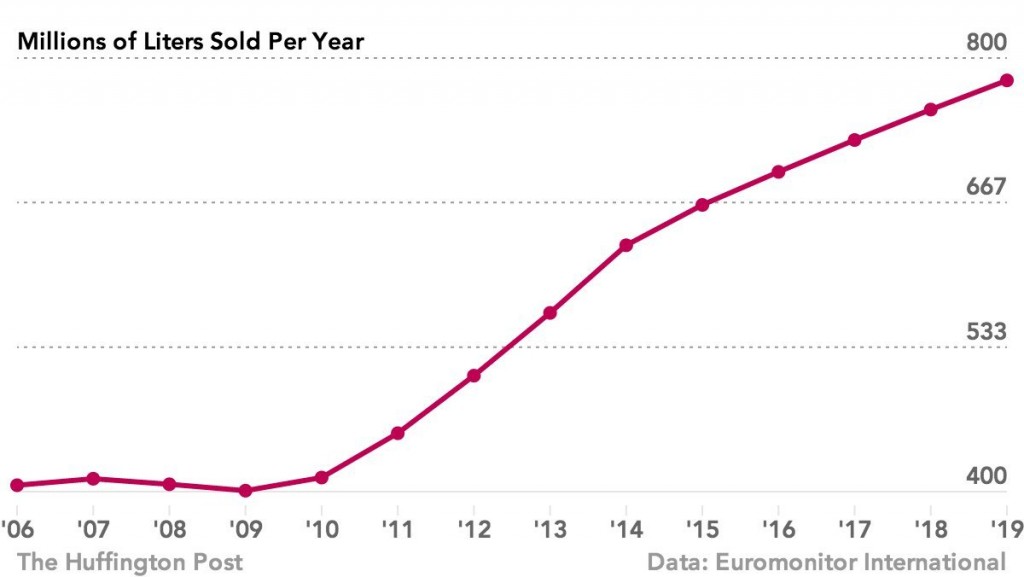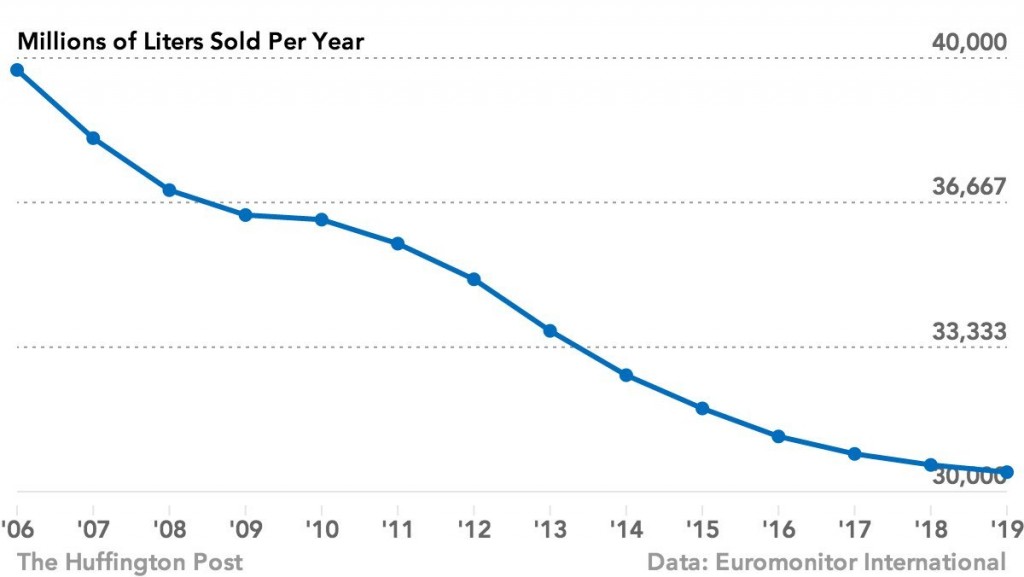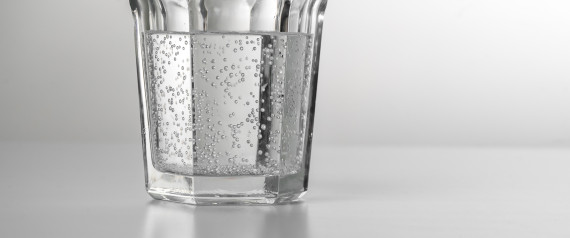The hottest drink in America is water with bubbles.
Long a kitchen table staple in European households, sparkling water is making inroads in the U.S. thanks largely to Americans’ waning interest in soda. Between 2009 and 2014, the volume of carbonated bottled water sold in the U.S. has increased by 56.4 percent, according to data from Euromonitor International, a market research firm. Soda drinking declined sharply during the same period.
Still, sparkling water sales are a fraction of soda sales. The U.S. soda market is worth about $39 billion, according to Euromonitor. The market for unflavored sparkling water, flavored sparkling water and “functional” water — a category that includes flavored still water and enhanced still water like Smartwater — is just $4 billion.
It has a way to go before it catches up to soda, but sparkling water is indeed having a moment.
The growth in millions of liters of sparkling water sold in the U.S.
 The decline in millions of liters of soda sold in the U.S. Note that the scale is very different from the chart above, with soda sales still dwarfing sparkling water sales.
The decline in millions of liters of soda sold in the U.S. Note that the scale is very different from the chart above, with soda sales still dwarfing sparkling water sales.

Americans’ growing obsession with health is the biggest reason for the shift, according to Jonas Feliciano, a global beverage analyst at Euromonitor. Coke and Pepsi have resorted to hawking products like energy drinks and even milk to boost sales as Americans become increasingly wary of the high levels of sugar in soda.
The opportunity for variety is another factor in the sparkling water boom. These beverages are available in a range of flavors, from orange-pineapple to kiwi-strawberry. Feliciano noted that most mainstream soda comes in just cola and lemon-lime flavors. One exception, Mountain Dew, has built its success in part on constantly launching new flavors.
“[Americans] are turning away from things that identify with soda and instead are turning toward things that identify with water,” Feliciano said. “If I’m looking for health and I’m looking for variety, sparkling water with different flavors seems to provide that.”
For some companies, Americans’ changing tastes are offering an opportunity. The growth in sales at Washington-based Talking Rain Beverage Company, which makes flavored sparkling water, has pretty much directly mirrored the rise of the beverage’s popularity. The company brought in more than $384 million in sales in 2014 compared to just $2.7 million in 2009. Sparkling Ice, a Talking Rain line of zero-calorie sparkling water in flavors like pink grapefruit and peach nectarine, is responsible for most of that growth.
Kevin Klock, Talking Rain’s CEO, says the company doesn’t try to make health claims about its drinks because shoppers recognize on their own that sparkling water is probably healthier than soda.
“It’s great that it’s zero calories, but it’s probably not the number one thing the consumer is looking for,” Klock said. “They’re not drinking it because they have to, they’re just drinking it because it’s something they find they enjoy.”
Sparkling Ice on display in New York.
Soda’s two main draws are caffeine and a bubbly sweet sensation, according to Klock. As concerns about soda’s health consequences mount, drinkers are turning to coffee and energy drinks for their caffeine fix, and flavored sparkling waters for that throat-tickling combination of bubbles and sweetness.
“I don’t see it as a fad,” Klock said of flavored sparkling water, noting that the trend in all beverages, including liquor and beer, is toward more variety and flavor.
SodaStream is betting big that interest in sparkling water continues to grow. The at-home carbonation machine company has shifted its marketing in recent months to focus more on the product’s ability to make sparkling water and less on its ability to make soda. SodaStream rebranded its devices as sparkling-water makers instead of soda makers, and it has changed its slogan from “set the bubbles free” to “water made exciting.”
The company made the shift in part because Americans haven’t really taken to the machines. In the U.S., SodaStream is probably better known for its Scarlett Johansson commercials than for its carbonation device. So far, just 1.5 percent of households in the U.S. have a SodaStream, compared to about 20 percent of households in Finland or Sweden, according to Daniel Birnbaum, SodaStream’s CEO.
Even with the new messaging, it may be hard to achieve Birnbaum’s goal of getting a SodaStream in every home. Feliciano notes that low-income shoppers aren’t likely to make the switch from soda to sparkling water anytime soon. Even those who don’t shell out for a SodaStream machine — the cheapest option on the company’s website is $79.99 — will probably find better deals on soda than sparkling water.
While there’s not that much difference in the average price per liter ($1.10 per liter for soda versus $1.30 per liter for sparkling water, according to Euromonitor), the supermarkets, discount outlets and convenience stores where most low-income Americans shop offer promotional deals on soda that often make it much cheaper than sparkling water, according to Feliciano.
“This is still not for the masses,” Feliciano said.
But Birnbaum is confident that Americans’ shift away from soda is more than just a whim.
“We feel like we are now at the early stages of a revolution in the beverage industry in America,” Birnbaum said, noting that about 70 percent of SodaStream’s customers globally use the machine only for carbonating water.
“The death of soda comes with the life of something else,” Birnbaum said.
Source: http://www.huffingtonpost.com/
Dear User/Visitor! Please, answer on our questions: tick off one of the positions – your answer will make us able to improve our site and make it more interesting and useful!


